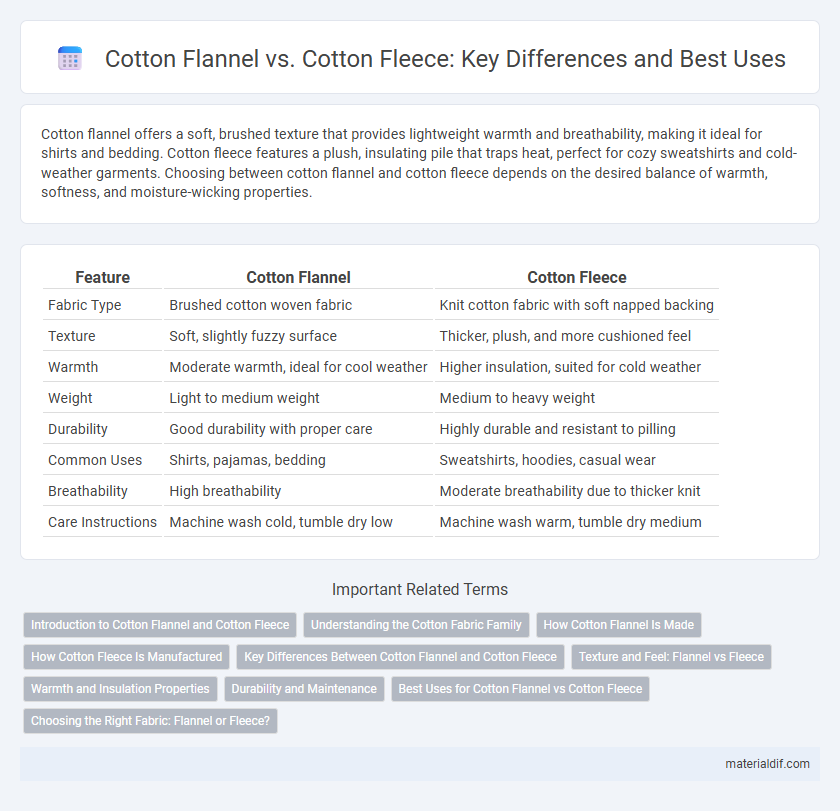Cotton flannel offers a soft, brushed texture that provides lightweight warmth and breathability, making it ideal for shirts and bedding. Cotton fleece features a plush, insulating pile that traps heat, perfect for cozy sweatshirts and cold-weather garments. Choosing between cotton flannel and cotton fleece depends on the desired balance of warmth, softness, and moisture-wicking properties.
Table of Comparison
| Feature | Cotton Flannel | Cotton Fleece |
|---|---|---|
| Fabric Type | Brushed cotton woven fabric | Knit cotton fabric with soft napped backing |
| Texture | Soft, slightly fuzzy surface | Thicker, plush, and more cushioned feel |
| Warmth | Moderate warmth, ideal for cool weather | Higher insulation, suited for cold weather |
| Weight | Light to medium weight | Medium to heavy weight |
| Durability | Good durability with proper care | Highly durable and resistant to pilling |
| Common Uses | Shirts, pajamas, bedding | Sweatshirts, hoodies, casual wear |
| Breathability | High breathability | Moderate breathability due to thicker knit |
| Care Instructions | Machine wash cold, tumble dry low | Machine wash warm, tumble dry medium |
Introduction to Cotton Flannel and Cotton Fleece
Cotton flannel is a soft, woven fabric known for its slightly napped finish, providing warmth and breathability, making it ideal for cozy shirts and bedding. Cotton fleece features a plush, brushed interior with a smooth exterior, offering superior insulation and comfort often used in sweatshirts and loungewear. Both fabrics utilize cotton fibers but differ in texture and warmth levels, catering to various cold-weather apparel needs.
Understanding the Cotton Fabric Family
Cotton flannel and cotton fleece both originate from the versatile cotton fabric family, but they differ in texture and warmth. Cotton flannel is a soft, woven fabric with a napped finish, ideal for cooler weather due to its breathable yet insulating properties. Cotton fleece, on the other hand, features a plush, knitted texture with a brushed interior that provides superior insulation and moisture-wicking capabilities, making it perfect for colder climates and active wear.
How Cotton Flannel Is Made
Cotton flannel is made through a weaving process using fine cotton fibers, followed by a careful brushing on one or both sides to create a soft, fuzzy surface that enhances warmth and comfort. The fabric typically features a twill or plain weave that provides durability and breathability. This brushed texture distinguishes cotton flannel from cotton fleece, which is constructed with a knit fabric and has a more plush, thicker pile.
How Cotton Fleece Is Manufactured
Cotton fleece is manufactured through a process of knitting cotton fibers into a jersey fabric, which is then brushed on one or both sides to create a soft, plush texture with raised loops or nap. This brushing process increases the fabric's insulation properties, making cotton fleece warmer and more suitable for cold weather compared to cotton flannel, which is typically woven and has a smoother finish. The combination of knitting and brushing defines cotton fleece's unique softness and thermal retention, distinguishing it from the woven and flatter cotton flannel.
Key Differences Between Cotton Flannel and Cotton Fleece
Cotton flannel is a soft, woven fabric known for its brushed surface that provides warmth and breathability, making it ideal for shirts and pajamas. Cotton fleece has a knit construction with a plush, napped underside, offering higher insulation and moisture-wicking properties, commonly used in sweatshirts and activewear. The primary differences lie in texture, warmth retention, and use cases, with flannel emphasizing softness and breathability, while fleece prioritizes thermal insulation and stretch.
Texture and Feel: Flannel vs Fleece
Cotton flannel features a soft, brushed texture that feels smooth and cozy against the skin, providing warmth without bulk, making it ideal for lightweight layering. In contrast, cotton fleece has a thicker, plush texture with a brushed interior that delivers superior insulation and a more cushioned, fleece-like feel, perfect for colder weather. The tactile difference lies in flannel's fine nap versus fleece's deeper pile, influencing warmth retention and comfort level.
Warmth and Insulation Properties
Cotton flannel offers moderate warmth and breathability, making it suitable for cool but not extreme cold weather. Cotton fleece provides superior insulation due to its brushed, napped backing, trapping more air and retaining heat effectively. For optimal warmth and insulation, cotton fleece outperforms cotton flannel in cold-weather clothing and bedding applications.
Durability and Maintenance
Cotton flannel offers moderate durability with a soft, brushed texture that may wear thinner over time, requiring gentle washing to maintain its feel and prevent pilling. Cotton fleece provides greater durability due to its denser knit and brushed inner layer, which resists wear while offering enhanced warmth; it typically withstands regular machine washing without significant fabric degradation. Proper maintenance of both fabrics involves avoiding high heat drying and using mild detergents to extend fabric life and retain softness.
Best Uses for Cotton Flannel vs Cotton Fleece
Cotton flannel is ideal for lightweight bedding, shirts, and pajamas due to its soft, brushed surface that provides warmth without heavy insulation. Cotton fleece suits cold-weather apparel like sweatshirts and hoodies, offering superior insulation and moisture retention through its dense, napped texture. Both fabrics excel in comfort, but flannel is better for moderate warmth and breathability, while fleece is preferred for insulation and durability in colder climates.
Choosing the Right Fabric: Flannel or Fleece?
Cotton flannel offers a soft, breathable texture ideal for moderate climates and layering, while cotton fleece provides a thicker, more insulating fabric suited for colder conditions. Flannel's brushed surface enhances warmth without excessive bulk, making it perfect for casual shirts and lightweight blankets. Fleece's plush pile delivers superior heat retention and moisture-wicking properties, preferred in activewear and heavy-duty cold-weather garments.
Cotton Flannel vs Cotton Fleece Infographic

 materialdif.com
materialdif.com